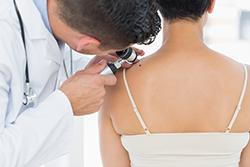Protect Your Skin this Summer
Skin cancer is nothing to take lightly. The American Academy of Dermatology states that one American dies each hour of every day from malignant melanoma. Add the morbidity rate from more common lesions--basal cell and squamous cell carcinomas--and the United States has a big skin health problem.

The Common Cause
Researchers agree that most deadly melanomas originate with over exposure to the harmful ultra-violet radiation of the sun (UV rays). Yet, who wants to avoid healthy, fun-filled outdoor activities during the summer months? The answer lies in common sense precautions as recommended by the team of board-certified dermatologists at Shady Grove Dermatology in Rockville, MD.
Protect Your Skin This Summer
It seems obvious, but many people don't think of it: just cover up. Clothes--long-sleeved shirts, long pants, and wide brim hats--protect skin from the sun. UV-blocking sunglasses shield skin around the eyes and prevent early cataract formation, too.
Another obvious protection is shade. Between the hours of 10 a.m. and 4 p.m., stay out of direct sun on the beach, tennis court or other areas. It's worth the effort to lug that big beach umbrella or to find a shady tree to set up the picnic table.
Of course, the doctors at Shady Grove Dermatology highly recommend the use of quality sunscreens. Apply SPF 15 for general use and SPF 30 when in and out of the water. Re-apply every two hours or more frequently if you are sweating heavily. When travelling for long periods of time in the car, provide little ones in car seats with window shades, and drivers should apply sunscreen to the left arm--a common site of skin cancers.
General Recommendations
Drs. Josef Yeager, Caroline Yeager, Sanders Berk and Thomas Keahey like to see their patients once a year for a general skin exam. Additionally, they ask their patients to visually inspect their skin at home once a month.
It's important to know the ABCDE signs of malignant melanoma and to apply them to any spots, moles or other lesions on your skin:
- A is for asymmetry. Moles should be symmetrical.
- B is for border. The border should be smooth and not etched or scalloped.
- C is for color. It should be uniform throughout.
- D is for diameter. 6 millimeters or more is usually diagnostic for suspicious lesions.
- E is for evolution. If a mole changes or evolves, call your Rockville dermatologist.
Have You Been to the Skin Doctor?
If not, make an appointment with Shady Grove Dermatology in Rockville, MD. Bring your questions about skin protection now that the sunny summer weather is here. Call the office at (240) 246-7417.